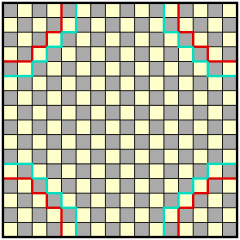
Games are modeled as a Search problem and heuristic evaluation function, and these are the two main factors which help to model and solve games in AI.Īlthough by using the above approach, it is theoretically possible to win any adversarial search based game like Chess, Tic-Tac-Toe, Backgammon, Chinese Checkers, Halma, etc in most cases not feasible to generate the entire search tree. So, searches in which two or more players with conflicting goals are trying to explore the same search space for the solution, are called adversarial searches, often known as Games. On each turn, a player either moves a single piece to an adjacent open square, or jumps over one or more pieces in sequence.Īdversarial search is a search where we examine the problem which arises when we try to plan ahead of the world and other agents are planning against us. For four-player games played in teams, the winner is the first team to race both sets of pieces into opposing camps. The game is won by being first to transfer all of one's pieces from one's own camp into the camp in the opposing corner. The game is played by two or four players seated at opposing corners of the board. Piece colors are typically black and white for two-player games, and various colors or other distinction in games for four players. Pieces may be small checkers or counters, or wooden or plastic cones or men resembling small chess pawns. The gameboard is checkered and divided into 16×16 squares. His inspiration was the English game Hoppity which was devised in 1854. A fairly skillful player should be able to find 50 different solutions without too much difficulty.(From Wikipedia) Halma is a strategy board game invented in 1883 or 1884 by George Howard Monks, a US thoracic surgeon at Harvard Medical School. This problem can be solved in several 100 ways, and the interest therefore derives from the variety of solutions. There is no compulsion to make any hop.Īn interesting Halma Solitaire problem requires the player to place 19 pieces in one of the yards and then in 19 moves position them in a symmetrical figure across the board's diagonal. A player may make several hops in one move, but may not combine steps and hops in a move.Ĩ. A player may hop over his own or another player's pieces and all hopped pieces are left on the board.ħ. 2- A HOP, by which a player moves his piece over a piece on an adjoining square and into a vacant square directly behind it.Ħ.

Two types of moves are permitted:- 1 - A STEP, by which the player moves his piece nto an adjoining square. Moving pieces may be done in any direction - straight or diagonally, forward or backward, to one side or the other.ĥ. A player may move only one piece in a turn.Ĥ. Turns pass clockwise around the table if there are more than two players. When there are 3 or 4 players, each one takes 13 markers and positions them on the 13 square areas.ģ. When there are two players, each takes a set of 19 pieces and positions them in the yards with 19 squares.Ģ. Starting positions vary with the forms of play.ġ. The game is won by the first player or pair to achieve this objective. The objective is for each player to attempt to move his pieces from his own yard into the yard diagonally opposite. The latter provides more scope for the partners to help each other. Partnership Halma may be played in two ways the first as pairs with pieces in adjacent yards or as pairs with pieces in the diagonally opposite yards. The game may be played by two players, 3 or 4 players playing separately, or by 4 players playing as partners.


The pieces may be small checkers or counters, wooden or plastic cones, or wooden or plastic men resembling small chess pawns. There are four sets of pieces - each of a different colour two sets of 13 and 2 sets of 19. In the corners there are heavy lines marking off each 'yard' or starting area of 13 squares with two diagonally opposite ones having an extra line marking out 19 squares. Halma is played on a board with 256 small squares, 16 along each side.

Equipment required: two coloured sets of 19 markers two coloured sets of 13 markers dice


 0 kommentar(er)
0 kommentar(er)
